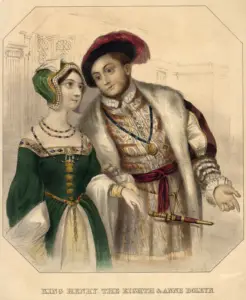 Did you know that Henry VIII and Anne Boleyn used a special love motif?
Did you know that Henry VIII and Anne Boleyn used a special love motif?
As well as using a cypher incorporating their initials, H and A, Henry VIII and Anne Boleyn used honeysuckle and acorns (I assume H for Henry and A for Anne). As historian and author Natalie Grueninger notes, “Honeysuckle has long been a symbol of love and devotion, while an acorn symbolizes fertility, growth and new life. It has also been used as an emblem of luck, prosperity and youthfulness.”1
Examples include:
- The use of the motif in “The Ecclesiaste”, a manuscript prepared for Anne by her brother, George Boleyn, Lord Rochford, probably in 1532 to celebrate her being created Marquess of Pembroke. Historian Eric Ives notes that the beginning of Chapter 6 opens with the word “Il” and that each side of the upright stroke of the I there is “a curved stalk in gold with eleven oak leaves, seven acorn cups (four full and three empty) and a honeysuckle bloom with a tiny tendril in white and gold”2.
- A carpet at Hampton Court Palace, recorded there following Henry VIII’s death: “carpet of gold, silver, and silk needlework with roses of red and white, and Queen Anne’s ciphers with a border about the same of honeysuckles, acorns, ‘H’ and ‘A’ of like needlework, fringed at both ends with a deep fringe and at both sides with a narrow fringe of Venice gold silver and silk and lined with green damask being in length three yards and in breadth two scant [nearly].”3
- A cushion at Hampton Court Palace: “a Cusshion nedlework of golde and Silke with a trail of honysocles and a bordre rounde about it with H of golde and knottes of silver…”4.
- Another cushion at Hampton Court Palace: “a Cusshion of nedlework on bothe sydes with Silke and golde thonesyde with a traile of H and A of venice golde and venyce silver and honysocles and Acornes of silke”.5
- Yet another cushion at Hampton Court: “a Cusshion of nedlework with Jellyflowers and other leaves of silke with a bordre abowte the same of honysocles strawbery flowers and acornes…”.6
You can see a photo of the honeysuckle and acorn motif from Anne Boleyn’s copy of The Ecclesiaste in plate 33 of Eric Ives’ “The Life and Death of Anne Boleyn”.
Notes and Sources
- “Anne Boleyn and Henry VIII’s Private Motif- Honeysuckle & Acorns” by Natalie Grueninger, 2 April 2011.
- Ives, Eric (2004) The Life and Death of Anne Boleyn, Blackwell Publishing, p. 243.
- Ibid., p. 253, quoting from Starkey, David ed. (1998) The Inventory of Henry VIII, no. 9219.
- Starkey, David ed. (1998) The Inventory of King Henry VIII: The Transcript, Society of Antiquaries & Harvey Miller, 9225.
- Ibid., 9226.
- Ibid., 9228.